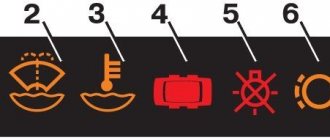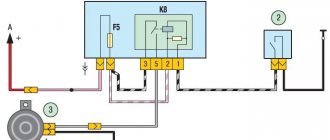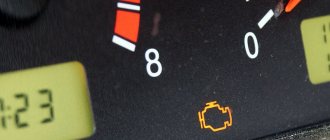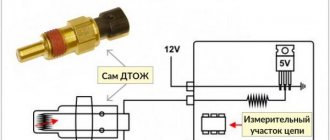Review of causes of glow
What to do if the LED lamp is on? There are several reasons why, after turning off the lighting device, the LED lamp continues to burn, even dimly or weakly:
- poor-quality insulation in a section of the electrical circuit or any other electrical wiring malfunction;
- the switch to which the LED lamp is connected is backlit;
- low-quality emitters are used in the design of the lighting source;
- special functionality of the lighting element.
Is this glow dangerous? This problem does not pose any danger to the wiring, but the service life of LED bulbs will be noticeably reduced if they constantly flicker or glow dimly.
If the switching device is in the off position, and the emitter still glows and burns, then it is best to check the last three factors first. This is explained by the fact that it is very difficult to find weak insulation areas in electrical wiring.
In order to do this, it is necessary to create special conditions, as a result of which a high voltage is applied to the circuit for one minute to cause a breakdown. The section of the circuit that causes the lighting element to glow after the switch is turned off will need to be opened. Moreover, if the electrical wiring was installed in a hidden way, then opening it will lead to damage to the integrity of the wall.
It is important to know! There are many situations where when LED light sources are connected to a backlit switch, they function differently. This occurs due to the fact that the lighting element, which is installed in the switching device, closes the circuit and, accordingly, passes a small current. This is what charges and allows the light bulb to glow when the switch is off.
Another problem why an LED lamp glows in the dark is the low cost of the product. If you purchased a poor quality LED light bulb, this can also lead to a similar phenomenon. This is due to the fact that there is some kind of error in the board. But it also happens that the emitter burns dimly due to the fact that it has its own peculiarity in the functioning of the structure.
We are talking about the processes that occur in capacitors when a load is applied to the lighting element. When electric current passes through the circuit, the capacitor stores energy, and then after the load is stopped, it continues to keep the elements glowing.
Another fairly common reason why LED lamps glow when the switch is off is incorrect connection. You can learn more about this from the video:
How to fix the problem?
If the LED lamp lights up when the light is off, how to fix it? There are different solutions. It all depends on the nature of the problem itself. For example:
- A cheap, low-quality LED lamp always glows in the dark after it is turned off. To eliminate this problem, it is necessary to replace it with quality products from a trusted manufacturer.
- If the lighting element is on because an illuminated switch is used, then this problem can be solved in different ways. For example, the easiest way out is to change the switch in the house to a regular one, without backlighting. You can simply cut off the specific wire that powers the backlight. This can be done after opening the switching device. But there is another way out - to preserve this function, it is enough to place a resistor in parallel on a certain section of the electrical circuit.
- If the LED light is on and the reason is in the wiring, then it will be extremely difficult to solve such a problem. To eliminate it, you need to find the location of the current leak. But this may entail certain difficulties. But when the light turns off, the bulbs will not light up. We talked about what malfunctions in electrical wiring can happen in a separate article. There is another way, simpler. When the lighting element is lit, it is necessary to connect a load (relay, incandescent lamp or resistor) in parallel with it. You just need to take into account the fact that the resistance in the connected load should be lower than in the light emitter. And as a result, the leakage current will flow to this load, but due to the fact that the resistance is insignificant, it will not light up.
Another effective way to eliminate the glow of LED bulbs is to add a capacitor to the circuit. This is explained in detail in the video tutorial:
A variety of methods can solve the problem of the glow of emitters with diodes so that they do not glow at full intensity when the switch is turned off. The main thing is to understand the root cause of the problem. We hope you now understand why the LED lamp glows after turning off and what to do to correct the situation!
It will be useful to read:
Source: samelectrik.ru
The lamp lights up after turning off - solutions to the problem
Having decided why the LED light is on when the light is off, you can move on to solving the problem. The following is a list of basic recommendations, depending on the causes of this phenomenon. If dim light is associated with purchasing a product at an affordable price, but of low quality, then the advice here is very simple - you need to go to the nearest store and buy a high-quality light bulb from a reliable manufacturer.
If the problem is the backlight in the switch, there may be several solutions. You can act logically and, following the example of the first point, go to the store for a switching device that does not have backlighting. Another option is to cut off the power wire that controls the backlight. To do this, you will need to open the switch, which is done quite simply and quickly; even beginners in this matter will be able to disassemble and reassemble the device on their own in a few minutes. If you cannot do without backlighting, then you can just install another resistor in the circuit, which will prevent the accumulation of energy.
The main thing is to find the cause of this glow, after which you can begin to take action.
Isolation, as noted earlier, causes the greatest difficulties in solving the problem. If you do not want to violate the integrity of the wall, then you can try to go the other way. Its essence is to connect an additional load (relay, resistor, incandescent lamp) in parallel with diodes that do not stop burning. The only condition is that the resistance of the connected additional device must be less than that of the LED lamp. Due to the weak resistance, the connected element will not light up, and due to the redirection of current, the LED lamps will also not light up after turning off.
So, we told you why LED bulbs light up when the switch is off, and also that solving such a problem is not so difficult. The main thing is to find the cause of this glow, after which you can begin to take action.
Features of LED lamps
LED bulbs have a slightly more complex internal structure compared to conventional incandescent bulbs.
Main elements of an LED lamp:
- Nickel-plated brass base. These materials avoid corrosion processes and also ensure good contact with the cartridge.
- The base of the plinth is made of polymer (polyethylene terephthalate). The material protects the device body from electricity.
- The driver is based on a galvanically isolated current stabilizer modulator circuit. The driver's task is to create conditions for stable operation of the light source even in the event of power surges.
- The radiator is made of anodized aluminum alloy. The coating allows heat to be removed from those surfaces of the lamp that are not allowed to overheat.
- Aluminum printed circuit board. The component guarantees the desired temperature regime for the chips by dissipating heat to the radiator.
- Chips. They represent a key element of the system. They are also called diodes.
- Diffuser. It is a glass hemisphere with the highest level of light dispersion achievable within the technology.
The operating principle of LED lamps is based on the release of photons. This occurs as a result of permanent change and the appearance of multiple combinations of electrons. Uninterrupted changes are ensured by the presence of conductors. To optimize the process, resistors or current limiting devices are used.
Recently, more advanced systems have appeared that provide high consumer performance. These bulbs use diode bridges. However, the prices for such lamps are much higher than for old-style products.
Tips for choosing LED lamps
When purchasing an LED cutter, it is recommended to pay attention to the following factors:
- Carefully read the instructions that come with the LED lamps. It specifies the rules for using the product.
- Some convenient lighting features are not easily compatible with LED bulbs. Timers, light intensity controllers, photovoltaic elements, and backlighting often cause failures in the normal operation of LEDs.
- Pay attention to the dimensions of the radiator. This element is responsible for removing a sufficient amount of thermal energy that is released when the light is on. The dimensions of the radiator and the power of the lamp must be consistent with each other.
- Radiator material. The best choice is an aluminum radiator. Ceramic and graphite products have proven themselves to be excellent.
- The quality of the joint between the light bulb body and the base. If there are obvious mechanical defects at the junction, the likelihood of problems with the lamp glowing when the switch is off increases. The base must be securely fixed to the body without play.
- Ripple level. The correct glow is uniform, without any flicker. However, it is quite difficult to notice irregularities in the light. This is where a mobile phone video camera comes in handy - it makes it much easier to spot flickering.
It is recommended to purchase products only from well-established manufacturers. A low price very often has a downside - insufficient product quality.
Source: stroyka.ahuman.ru
Why does an LED lamp continue to burn dimly when the lights are off?
There are several reasons why an LED lamp continues to burn dimly even after being turned off, and there are several suggestions for eliminating them.
LEDs may burn dimly due to the poor condition of the wiring and its poor-quality insulation, incorrect connection of the lamps and their poor quality.
Poor quality insulation
If the wiring is old and the insulation is of poor quality, the LED lamp may burn dimly even when the light is turned off.
Poor-quality insulation allows current to pass, which is enough to make the LEDs glow weakly.
The difficulty in solving the problem of poor insulation is that you need to have special instruments to detect it. And if the wiring was installed in a hidden way, then you will need to open a section of the wall.
Illuminated switches
If your home has backlit switches, then when purchasing LED bulbs and strips you should pay attention to the instructions for their use. The packaging may indicate that this type of light bulb is not recommended for use with switches that have a backlight.
LEDs have a filter capacitor designed to smooth out the voltage. This device accumulates voltage inside itself, which “turns on” the LED light bulb.
When the light is on, all input voltage goes to the lamp. When the lights are turned off, the electrical circuit is open, but a small amount of current continues to flow to power the LED or neon light bulb in the backlight. The current, even such a small power, is enough to start the diodes, which begin to blink or glow dimly.
What should I do to make the lamp stop glowing or blinking when turned off?
Having done this, no current will flow to the charging capacitor, after which the lamp will no longer glow dimly or blink;
If you want to avoid this problem, then before purchasing a switch, pay attention to the presence or absence of backlighting. If it is not there, then the main problem will not appear; A good option would be to connect a regular lamp in parallel; using this option will prevent the energy-saving light source from burning when turned off.
This is achieved due to the fact that the current to recharge the capacitor will go to the filament (This method is not very good for just one reason. The purpose of purchasing LED lamps is to save energy and have a longer service life compared to incandescent and halogen lamps. When added to the circuit of a conventional lamp increases consumption, and accordingly all savings are lost. As a result, this solution is not ideal);
There are switches that have mandatory backlighting needed for some purpose. What to do in this case, and what actions to take?
A good solution to eliminate this problem would be to connect a resistor in parallel, which will help create additional resistance in the desired section of the electrical circuit. The main advantage of this method is its cheap price; you can purchase a resistor in absolutely any radio equipment store.
It is worth noting that the resistor will not negatively affect the normal operation of the LEDs. But when the switch is turned off, the backlight will work, and accordingly the resistor will consume current, which goes to charge the capacitor. Also don't forget to insulate the resistor, the best way to do this is to use heat shrink tubing.
You can connect it under the ceiling in a lampshade or in a lamp socket. For a more convenient connection of the resistor, a good option would be to use special Wago terminal blocks (in the image below).
The final step is to place the resistor in the box, after which you can enjoy the absence of blinking of the LED lamp after turning off.
Today, LED lamps have become the most popular light sources and there are many explanations for this: they are economical, fireproof, have the longest service life and also create the most comfortable lighting for vision. However, as with other alternative light sources, LEDs have their own problems. The most common is when the LED lamp glows after being turned off. We discussed the reasons for this phenomenon and ways to eliminate the glow in this article.
Features of the power supply circuit
There are two schemes for connecting LED lamps:
- with LED driver,
- with power supply.
In the second case, it is necessary to use a resistor that limits the current. You can find out the required power when purchasing it in a store.
The resistor has the ability to accumulate thermal energy, which is enough to dimly glow when the LED lamps are turned off.
If we are talking about T8 LED lamps (in the form of a tube), then connecting them to additional devices is not required - everything you need is in the lamp itself.
This is interesting! There are LED lights designed specifically to accommodate LED bulbs that will not dim when turned off.
If you want to replace an incandescent light bulb in a lamp with an LED one, then the voltage on its packaging should indicate 220 V. Next, we select according to the type of base (for example, E14 or E27 are the most common). In order not to make a mistake with the size of the base, you can take an old light bulb to the store.
Poor quality wiring
Another common reason why LED bulbs light up when the switch is off is faulty wiring. You should seriously think about repairing it if:
- aluminum wires have been in use for more than 30 years;
- problems arise with LED lamps from different manufacturers;
- the switch that opens the circuit with the LED lamp does not have a built-in backlight.
Electrical wiring can affect the operation of an LED lamp in two cases:
- The phase and zero are swapped, that is, the phase wire goes directly to the cartridge, and the zero wire goes directly to the switch. In this case, the LED spotlight driver or bulbs are constantly energized, causing the LEDs to either dim or flash despite the electrical circuit being open. The problem is solved by reconnecting the wires in the junction box so that the “phase” goes to the switch, and the “zero” goes to the lamp.
- Another malfunction is a violation of the integrity of the hidden wiring, or rather the insulation of one of the wires. As a result, a small leak occurs inside the reinforced concrete wall, and the LED lamp continues to glow after the light is turned off. Using a megohmmeter, you can measure the insulation resistance and make sure that its value is underestimated. But it will not be possible to determine the location of the breakdown. Therefore, there is only one way out - to replace the section of wiring from the junction box to the chandelier.
Read also: Vladimir Leonov quantum engine
If you are unable to solve the problem of the harmful glow of switched off LED lamps on your own, write about it in the comments - we will try to help with useful advice.
Light diodes are built from a matrix of semiconductor crystals located on a panel and placed in a frosted bulb. The assembly generates light of different color temperatures, which is controlled by the color of the bulb and the chemical composition of the semiconductors. High-quality products have a long service life, are reliable in operation, resistant to mechanical stress, heat up slightly and are slightly sensitive to voltage changes.
However, some LED lighting products do not meet all declared characteristics. There are some reasons why an LED lighting lamp with an E27 socket can glow as if at half power. There are two main factors:
- defective driver resistor;
— diodes of poor quality;
- faulty electrical wiring.
Often, manufacturers do not comply with circuit assembly specifications and include defective, cheap parts. During assembly, the diodes are soldered onto a plate, on the back of which an aluminum layer is installed, which acts as a heat-dissipating part. To prevent overheating of the LEDs and ensure high-quality heat dissipation, the metal part is coated with heat-resistant paste. If the paste is applied unevenly, the life of the lamp will be significantly reduced.
What to do and how to fix the problem
You can eliminate the causes of dim LED lighting yourself or, in some cases, by contacting an electrician.
The problem of poor wiring insulation can be solved by replacing it or re-insulating the damaged area. The location of poor-quality insulation is determined by special devices (homemade or purchased) in this way: within a minute, the maximum voltage is applied to the network and, with the help of special equipment, the location of the current leak is found. If you have no knowledge of electrical engineering, then it is better to trust a specialist.
Many manufacturers have begun to write on the packaging of LED lamps that their use is not recommended if there is a backlit switch. If there were no instructions on the packaging, you screwed the LED light bulb into the lamp, and it continues to glow faintly when turned off, you should try the following:
- replace the backlit switch with a regular one;
- remove the backlight (cut the wire that goes to the backlight bulb);
- Screw one incandescent lamp into the lamp, which will receive “extra” voltage. The value of this method is questionable, since it contradicts the idea of saving electricity;
- install an additional resistor with a resistance of 50 Ohms and a power of 2-4 W, which can be purchased at the store. Its connection is made parallel to the lamp in the ceiling lamp or in the socket, and the installation site is necessarily insulated with heat-shrinkable tubing. Thus, the voltage will not go to the LED light bulb, it will not light up after turning off, but the switch will remain illuminated.
LED lamps can burn when the switch is off due to the specificity of their design. Thus, the LED driver includes a capacitor capable of storing electricity. This design feature of LED light bulbs does not allow them to go out immediately after turning off, and they continue to glow faintly.
It is not recommended to purchase products from unknown manufacturers. They will not work correctly and will not last long and will burn after being turned off. In addition, a defective product can cause harm to the eyes due to flickering, white color temperature (instead of the declared warm light), etc.
If the electrical wiring is old, it must be replaced. In this situation, the best solution is to entrust the work to an electrician.
If the zero and phase are connected incorrectly, you need to reconnect: the phase to the switch, and the neutral wire to the light bulb.
The problem can be eliminated by purchasing a resistor made of special materials that prevent the accumulation of thermal energy.
Tips for choosing LED lamps
Organizing lighting with LED lamps is economically beneficial, but requires a certain approach to their selection.
The first thing to remember is that LED lamps cannot be cheap. Their design is very complex and requires certain production costs.
The second point is the instructions included with the light bulb. Study it carefully. Points that you should pay attention to in order to choose a high-quality light bulb that does not blink when turned off:
- Is it possible to use LEDs in lamps that illuminate a switch, dimmer or motion sensor;
- the warranty period must be at least 3 years;
- there should be no nicks or other defects at the junction of the base and the body;
- on the dimensions and material of the LED lamp radiator. The best is the ribbed aluminum version. Cheaper, but also reliable, is aluminum, which is covered with a layer of plastic;
- to the input operating voltage. LEDs operate on voltages of 12 and 24 Volt strips and 220 V bulbs;
- to the pulsation level. If it is indicated that there is no pulsation, it means that it is very low (in any case, the light bulbs emit pulsating light) and will not cause harm to the eyes.
Attention! Some types of lamps have the ability to glow after being turned off. You will find information about this in the instructions for it.
More than half of the reasons for LEDs dimming when turned off is a backlit switch or poor quality of the light bulb.
To prevent combustion when switched off, when purchasing, you need to carefully read the instructions and choose a light bulb that suits the specific case.
Sometimes it is impossible to completely eliminate the weak burning of LED lamps when they are turned off. Their design is complex, and even trusted manufacturers can have similar problems (although less often than manufacturers of low-quality light bulbs).
Source: svetilnik.info
Why the LED lamp barely burns - reasons
There are several reasons why an LED lamp or lamp shines dimly:
- Use of low-quality components. Unscrupulous manufacturers may install a weak heatsink (which will cause the LEDs to overheat and fail), or use an unsuitable CHIP element. All this leads to a decrease in the brightness of the light flux.
- Natural degradation of LEDs. This process happens sooner or later with any LED lamps. Usually the degradation period is written on the packaging. If the period of appearance of dimness coincides with the manufacturer's stated data, it is time to change the lamp.
- Low mains voltage. A rare but common factor. This can be checked using another lamp. If it shines just as dimly in the lamp, you need to call an electrician.
- Wrong choice of lamp characteristics. Carefully read the instructions for the lamp - it indicates what power and brightness the light source should be. Or focus on the performance of the old lamp.
In order not to ask yourself the question why the LED lamp barely lights up, choose products only from trusted manufacturers - for example, retrofit lamps from LeDron. The product warranty will allow you to simply change the lamp if you come across a product with a manufacturing defect.
Features of LED lamps
LED bulbs have a slightly more complex internal structure compared to conventional incandescent bulbs.
Main elements of an LED lamp:
- Nickel-plated brass base. These materials avoid corrosion processes and also ensure good contact with the cartridge.
- The base of the plinth is made of polymer (polyethylene terephthalate). The material protects the device body from electricity.
- The driver is based on a galvanically isolated current stabilizer modulator circuit. The driver's task is to create conditions for stable operation of the light source even in the event of power surges.
- The radiator is made of anodized aluminum alloy. The coating allows heat to be removed from those surfaces of the lamp that are not allowed to overheat.
- Aluminum printed circuit board. The component guarantees the desired temperature regime for the chips by dissipating heat to the radiator.
- Chips. They represent a key element of the system. They are also called diodes.
- Diffuser. It is a glass hemisphere with the highest level of light dispersion achievable within the technology.
The operating principle of LED lamps is based on the release of photons. This occurs as a result of permanent change and the appearance of multiple combinations of electrons. Uninterrupted changes are ensured by the presence of conductors. To optimize the process, resistors or current limiting devices are used.
Recently, more advanced systems have appeared that provide high consumer performance. These bulbs use diode bridges. However, the prices for such lamps are much higher than for old-style products.
Why does the LED lamp glow when the switch is off?
There are several common reasons why LED bulbs glow when the switch is off:
- Low quality insulating materials.
- Using an illuminated switch.
- Low quality light bulb.
- Problems with electrical wiring.
- Features of the power supply circuit.
Poor quality insulation
Insufficient quality insulation in any part of the electrical circuit often causes problems with light. This malfunction has the most serious consequences, because to correct it you will need to disturb the finishing layer on the walls in order to replace the insulation.
To check the insulation for current leakage, apply high voltage to the network for 1 minute. This is necessary to simulate the conditions under which breakdowns occur in the electrical circuit.
Using Illuminated Switches
The answer to the question of why an LED lamp glows when the switch is off lies in the use of an illuminated switch. The inside of such a device contains a light diode with a current-limiting resistor. The reason the lamp glows is that even when the contact is disconnected, voltage still passes through them. However, the light bulb does not glow at full power, since the circuit contains a current-limiting resistor.
The lamp shines either constantly (if the current is sufficient) or intermittently (flashes because the current is too weak). However, even in the latter case, the current is sufficient to recharge the capacitor. As soon as sufficient voltage accumulates in the capacitor, the stabilizer chip turns on, and the light bulb immediately lights up. Operating the lamp in this mode leads to its rapid wear, since the number of operation cycles for microcircuits is finite.
In this case, there are several methods to eliminate the problem of the luminous light bulb. The easiest way is to remove the backlight from the switch. To do this, dismantle the housing and remove the wire directed to the resistor or light diode. It is also possible to replace the switch with another one that does not have a backlight function.
Another way to solve the problem involves soldering a shunt resistor parallel to the light bulb. You will need a 2 watt resistor with a resistance of up to 50 kOhm. If you do this, the current will flow through this resistor, and not through the light bulb power driver. Installing the resistor is not difficult. You just need to remove the lampshade and secure the resistance legs in the terminal block for connecting the network conductors.
It is enough to connect one resistor to the switch, there is no need to hang them on each lamp.
If you do not have sufficient knowledge of electrical engineering, you can do something simpler. To do this, place a regular incandescent lamp in the lighting fixture. The spiral of the light bulb will serve as a shunt resistor when turned off. However, this option is only suitable if there are several cartridges in the lighting fixture.
Low quality light bulb
Often the cause of a malfunction is an insufficiently high-quality lamp. In this case, there is only one way to solve the problem - replacing the product with a better one.
Electrical wiring problems
If errors are made during the installation of electrical wiring, one of the consequences of this may be the lamp glowing when the switch is already turned off. This situation happens when the zero is confused with the phase, and even after disconnecting the wires remain under the phase.
The situation should be corrected not only to get rid of the unnecessarily shining light bulb. This is also to avoid electric shock when replacing the lamp.
Features of the power supply circuit
To provide a brighter glow and reduce light ripple, a high-capacitance capacitor is sometimes added to the power supply circuit. This results in the fact that even when the switch is turned off, there is still enough charge in it to allow the LEDs to glow.
LED lamps glow after switching off: troubleshooting
If the reason for the glow of LED lamps is a backlit switch, then in this case you can do without altering or replacing it. To do this you need to do the following.
In order to troubleshoot the problem you must:
- Select a capacitor;
- Integrate a capacitor into an electrical circuit.
First of all, an additional element in the form of a capacitor is selected. This circuit is known to many, but when designing it, one mistake is made, which leads to the failure of the capacitor.
This is an incorrect device selection based on voltage. It is known that a current with a voltage of 220 Volts is used for the public network. This indicates that this voltage is active.
Note! The value of the effective voltage is equal to the maximum voltage (amplitude) divided by the root of two.
This suggests that when a maximum voltage value occurs in the network, the capacitor may not withstand the load and fail. Therefore, to install capacitors in a 220 Volt circuit, it is best to use capacitors with a rated voltage of 630 Volts and a capacitance of 0.1 µF.
If the reason for the glow of LED lamps is a backlit switch, then in this case you can do without altering or replacing it
Once the correct capacitor has been selected, you can begin installing it. To do this, you need to solder two wires about 5 cm long to its contact legs. Next, the device is mounted in the circuit. Installation is carried out in parallel. Polarity is not required.
Mount the capacitor in the junction box, to the wires going to the lighting device, or to the contacts of the cartridge.
Tips for choosing LED lamps
When purchasing an LED cutter, it is recommended to pay attention to the following factors:
- Carefully read the instructions that come with the LED lamps. It specifies the rules for using the product.
- Some convenient lighting features are not easily compatible with LED bulbs. Timers, light intensity controllers, photovoltaic elements, and backlighting often cause failures in the normal operation of LEDs.
- Pay attention to the dimensions of the radiator. This element is responsible for removing a sufficient amount of thermal energy that is released when the light is on. The dimensions of the radiator and the power of the lamp must be consistent with each other.
- Radiator material. The best choice is an aluminum radiator. Ceramic and graphite products have proven themselves to be excellent.
- The quality of the joint between the light bulb body and the base. If there are obvious mechanical defects at the junction, the likelihood of problems with the lamp glowing when the switch is off increases. The base must be securely fixed to the body without play.
- Ripple level. The correct glow is uniform, without any flicker. However, it is quite difficult to notice irregularities in the light. This is where a mobile phone video camera comes in handy - it makes it much easier to spot flickering.
It is recommended to purchase products only from well-established manufacturers. A low price very often has a downside - insufficient product quality.
Source: 220.guru
Why does an LED lamp burn at full intensity - features of the design and operation of the lamp
The design of an LED lamp consists of a base, driver, radiator, bulb and board with LEDs. The light source is powered through an alternating electric current network, the voltage of which is reduced by the driver. The radiator is responsible for removing heat from the LED elements - they heat up when the lamp is on. If an LED lamp is used instead of a traditional incandescent or halogen lamp, it is necessary to select the power and brightness corresponding to the previous light sources and luminaire.
These features of the operation of LED lamps make it possible to understand why the LED lamp burns at full intensity. It is worth noting that a frequent search on the Internet that includes the word “in full swing” is incorrect. The correct word to use is “full heat”.











